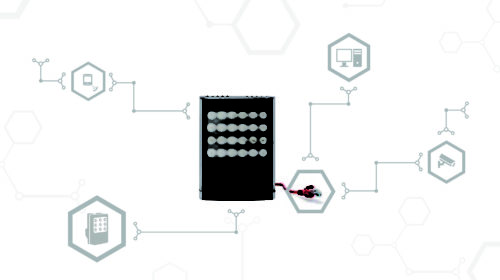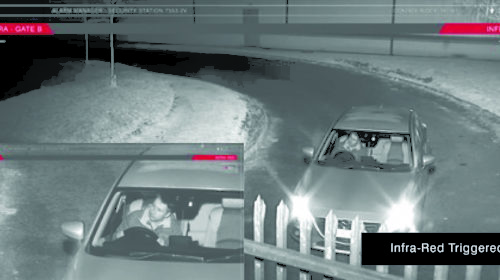Connectivity is the heartbeat of smart technology. Connectivity between devices improves the quality of decision making from each device, the level of service that each device can provide, and magnifies the value of the overall system. A truly smart device can make relevant decisions, whether that decision is a recommendation on Netflix or Spotify, automatic windscreen wipers that operate when rain is detected or smart heating that turns on 30 minutes before we arrive home from work.
To be smart a device has to be connected to other sensors, whether in-built or external, and make connection to them quick and easy. Consider a modern car, it is packed with internal sensors that monitor speed, tyre pressure, temperature, rainfall, lane departure, parking distances, seat-belt sensors, and also integrates with external devices such as GPS and modern smart phones that allow hands free calling, email and SMS message reading.
But how does this trend for connectivity affect the professional security systems and surveillance lighting, and what new trends are being seen. Whenever smarter devices are demanded, they are expected to be able to communicate with one another, with easy central management in one place.
What does connectivity mean for surveillance lighting
Most modern surveillance systems are now IP based. It’s not only been a definite trend in the security industry for a number of years, but it’s become an expectation that our surveillance systems will connect one to the site at any given time, and allow to respond quickly to alarms or events.
This need for connectivity within video surveillance systems, and the need for good night-time pictures have fuelled the development of IP lighting and the latest Network Illuminators such as Raytec’s VARIO2 IP that allows security professionals to provide lighting on-demand, delivering the appropriate lighting response to any event. With full IP addressability security professionals are always connected to their network illuminators, and with a simple click can instantly provide real-time responses to security events, even before personnel can be alerted or arrive on site.
Within larger systems and unmanned sites automated network lighting provides a dynamic response to on-site activity. Smart and programmable, IP lighting can be configured to meet the exact needs of any security system. It can be fully integrated with and triggered via your VMS/ BMS systems, IP cameras, detection systems, and all other network devices via simple HTTP commands, API or even externally via telemetry input. Network lighting can also trigger and control other devices on the network, for example switching the camera into night mode when darkness is detected.
The possibilities for configuring IP lighting are endless. IP lighting not only allows one to stay completely connected to our illuminators, but also enables a deeper integration with other devices, connects him to all activity on site, and increases safety and security all round.
Easy set-up and commissioning
Installation, setup and commissioning are made significantly easier for security professionals through the use of IP addressable network lighting. Gone are the days illuminator settings were adjusted in situ, often up a ladder or lift. With network lighting, installers now have quick access to configure all lighting settings via an integrated web interface from any remote network location.
Adjusting the illumination had often been a time consuming part of any security installation and often involved a 2 person trip to site at night to achieve the best results. But with network lighting, set-up becomes a 1 person job done safely from ground level anywhere on the network. One can remotely adjust the lighting levels and fine-tune the CCTV images in real time, side by side with the camera viewer. This significantly reduces visits to site and minimises labour time and costs. One can also setup illuminators individually or in groups for quick and easy operation of large sites.
Network lighting raises the bar for night time performance. We no longer have to settle for images that could be improved, or wait for an engineer to go to site to make operational changes. For example one can remotely alter the photocell sensitivity to change the time that the lighting turns on and off. He can also change the grouping of illuminators at any time, alter the way in which the lighting is triggered, and use timer settings to configure the duration that lighting may be activated on alarm – all done remotely via the illuminator’s web interface.
In the rare occasion that an issue occurs with an illuminator, remote diagnostics can be proactively carried out over the network to instantly troubleshoot the problem – again significantly reducing time on site.
The development of Network Lighting completely changes the way one thinks about lighting and how he plans the installations. It gives him the platform to achieve a much higher performing system with improved images, and increased security and safety 24/7.
Take live control
All cameras need light to see during the hours of darkness. But with IP based security systems on the rise, it’s Network Lighting which not only helps generate good night time images, but which works with the entire IP system to help stay connected to the site at all times.
Being IP addressable, Network Lighting is designed to deliver the right amount of lighting exactly when and where needed. Whether controlling it via its web interface, the VMS/ BMS, or other platform integration, one has the ability to take control over the lighting at any time to respond to live events there and then.
For example, the detection system may identify movement out of hours and raise an alarm. Before taking action, such as deploying a guard or even a police response, it is critical to investigate who or what is there. This is where high quality, dynamic lighting is essential. Knowing the camera location, one can take control over the adjacent Infra-Red lighting to review the situation. He can increase lighting levels to generate more detailed picture information and support cameras zooming into the scene, or decrease the lighting levels to avoid overexposure of subjects up close.
Visible White-Light can also be triggered on demand to provide colour CCTV images, or lighting for staff coming to attend the situation. In the case of a serious security breach, one can also flash deterrent lighting to proactively deter any crime from taking place. LED based network lighting in particular is crucial for triggering lighting on demand. LED lighting provides an instant start-up compared to other traditional solutions which require a significantly longer time to warm up.
Network Lighting is a perfect solution for systems looking to reduce light pollution (if using visible White-Light), or conserve running costs by turning lighting off out of hours. Even if one is using highly sensitive low light cameras he still needs adequate lighting to generate detailed, useful images at night. With the ability to trigger lighting on-demand, operators can use their Network Lighting only when they need to – fully supporting all cameras, whilst keeping running costs and disturbance to an absolute minimum.
Network Lighting not only helps achieve the best images in any environment, but allows to be actively responsive to any situation, in any place at any time. This is an advantage for all manner of security systems – because no one can be everywhere at once.
Lighting has always been an essential component of high security video surveillance systems but has historically been treated as a stand-alone accessory. However, with the development of Network Lighting, it firmly places illumination at the very core of our security systems and unlocks more intelligence than ever before. It enables to use lighting as an interactive and dynamic tool which can respond instantly to any situation at any time.
IP Lighting can be fully automated to operate even if the site is unmanned. It can be triggered from any alarm or event on the network through integrations with other network devices, including VMS/ BMS systems, cameras, detectors and many more.
For example one may be using invisible Infra-Red lighting to help the cameras generate detailed night-time images, and also help the video analytics to accurately identify any intruders and relay a reliable alarm. He can trigger an AUTOMATIC lighting response from any system alarm or event.
With the ability to group your lighting into key operational zones, one could trigger the whole perimeter fence line of illumination into deterrent mode (flashing) in response to a security breach. This will provide a highly effective warning and proactively deter any crime from taking place.
Without good illumination at night it’s likely that the camera would generate fairly noisy images. Even a small amount of noise can significantly inhibit the analytics from working with the risk of generating false alarms – rendering lighting response inefficient.
Network Lighting can be tailored to deliver different responses depending on the situation in hand. As well as providing event driven lighting, the White-Light could also be used to provide lighting for personnel. One may choose to trigger the lighting during the hours of darkness when the site is still operational (i.e., 6pm-11pm) – set at 20% output to conserve energy, but configured to provide 100% light output only when activity is detected – i.e., a car entering a carpark or a patrol. Once the site is completely closed, the White-Light can then automatically turn off, leaving the Infra-Red to monitor the scene covertly.
IP addressable Network Lighting can also be integrated with any other network device through simple HTTP commands. Integration possibilities are endless and include motion detection, audio detection, ANPR/ LPR, incorrect/ correct PIN access and many more, allowing one to fully automate the lighting via much simpler system integration.
An efficient system should deliver the right amount of lighting exactly when and where it is needed to achieve the best images at all times. But automating a Network Lighting to respond to any event, anywhere, is the smart choice for staying in total control at all times.
The future of network surveillance lighting
The future of Network Lighting is even more powerful and has more functionality than a smarter IP platform.
More power
As a global growth technology, LEDs are becoming increasingly powerful. Today’s illuminators, using the latest LEDs can deliver over 200% more power and light output compared to illuminators that are only 2-3 years old. So illuminators are now delivering much more performance, or to look at it another way, the same performance can be achieved from a physically smaller illuminator. This makes it much more economical to support every camera with good illumination at night.
More functionality
As the light output of LEDs increases fewer LEDs are required – even though the same physical footprint is required to maintain proper heat sinking. For manufacturers, this means more available real estate on an illuminator for increased functionality
Raytec firmly believe that this technology trend paves the way for the next surveillance lighting innovation – Network Hybrid Lighting.
Network Hybrid Lighting delivers the power of two whole illuminators, one Infra-Red and one White-Light, in a single IP PoE platform. It is the most connected lighting solution available on the market and opens up a whole new realm of possibilities for smart and intelligent lighting.
Having both IR and White-Light capability in one product provides an even quicker and even more dynamic security response – automatically changing to suit the needs of your site. The same illuminator can deliver Infra-Red for covert surveillance and then trigger White-Light on demand; either as a visual deterrent with a flashing output, for staff safety or for additional scene information for colour cameras.
A hybrid IP lighting solution makes it much more economical to deploy both Infra-Red and White-Light technology throughout a site. Previously, a security system requiring both Infra-Red and White-Light would have had to purchase and install two separate network illuminators to achieve the advantages of both Infra-Red and White-Light. Now, Network Hybrid Lighting not only provides increased functionality and improved security, but reduces infrastructure, cabling and capital outlay by half.
Raytec see the functionality and performance of Network Illuminators continuing to develop over the next few years. Network illuminators are defined by their ability to be tailored for any installation so future developments will concentrate on giving each illuminator more flexibility. Technologies such as marine grade construction, extreme temperature ratings, high vibration and salinity resistance, and direct IP-based lighting angle control will be compressed into smaller efficient platforms and included in-the-box, allowing security professionals to use any or all of the functionalities best suited to improve the performance of their video surveillance system at night.
The future of surveillance lighting firmly lies in network solutions. Good lighting for better night time pictures is always the basic drive in any surveillance – but more IP control gives even better.
“We are seeing a significant increase in demand for Network Illuminators because security professionals want to integrate lighting into their video surveillance system. A logical next step is Hybrid Network Illuminators that can deliver the right type, the right amount, and the right duration of light required for any situation, moving away from the practise of specifying separate Infra-Red and White-Light illuminators.”
– Tony Whiting
Raytec, Managing Director (Joint)